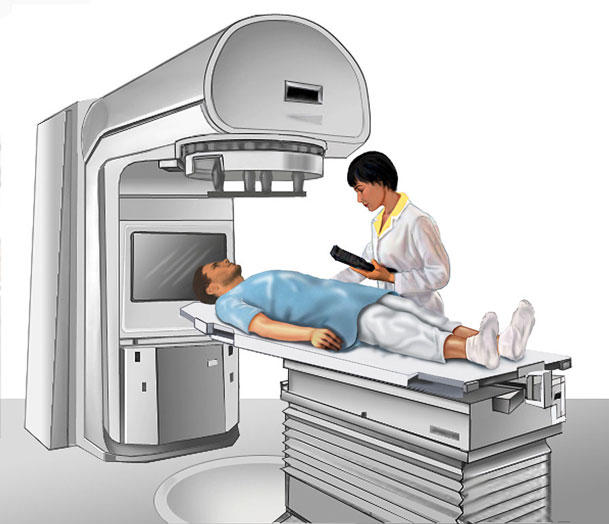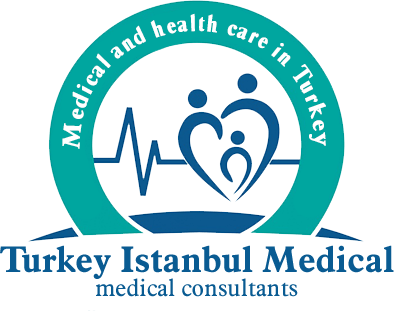What is Radiotherapy?
Radiation therapy is a type of cancer treatment in which intense energy beams are used to destroy cancer cells. Radiation therapy in cancer treatment mostly uses X-rays, but protons or other forms of energy are also sometimes used.
The term “radiation therapy” often refers to external beam radiation therapy. During this type of radiation therapy, high-energy ionizing lights come from a machine that aims it at a specific spot on the body. During a different type of radiation therapy called brachytherapy, radiation is placed inside the body.
Radiotherapy damages cells by removing the hereditary material that controls how cells grow and divide. While this form of treatment damages both healthy and cancerous cells, the aim is to destroy as few normal healthy cells as possible. However, normal cells often repair nearly all damage caused by radiation.
Why is Radiotherapy Applied?
Radiation Therapy (Radiotherapy) is mainly used for therapeutic purposes or to reduce symptoms in certain types of cancer. In this sense, it has been found that various types of cancer are more sensitive to radiation therapy. In these cancer types, Radiation Therapy (Radiotherapy) can be applied alone or in combination with chemotherapy. The point to be considered here is that radiotherapy can be applied in certain cases because the type of radiation used in Radiation Therapy (Radiotherapy) can reach certain tissues more easily and the desired effect is better seen in certain cancer cells.
In addition, in cancer types treated surgically, cancer cells that cannot be seen in the surgical area or other tissues of the body, which are microscopic in size and cannot be surgically removed, can survive in these tissues. In order to eliminate these cells, chemotherapy or radiotherapy can be applied as supportive treatment after surgery.
By Who Is Radiotherapy Performed?
Radiation therapy is a team work, it is a group of radiation oncologists, radiation physicists, dosimetrists and technicians, and we also have nurses who support us in this regard. As a result, a program is prepared and a treatment is determined for the patient. Physicians and doctors plan the radiation therapy planning together, but the technicians do it.
There are two types as internal and external application in patients receiving radiation. Generally, in external applications, patients receive their treatment and go home. It does not carry any radiation on it, so it will not harm the pregnant, child or babies around it.
-
Adjuvant Radiotherapy:
Adjuvant radiotherapy, which can be applied in many different cancer types, especially breast cancer, can also be defined as postoperative radiation therapy. It is aimed to destroy the cancer cells that may remain in the body, thanks to the application performed after the surgical removal of the tumor tissue. Thus, it is tried to prevent the recurrence (recurrence) of the cancer.
-
Primary Radiotherapy:
It is a type of radiotherapy applied alone in some cancer types such as laryngeal (Voiceal Cords) tumor. This method, which can also be defined as only radiotherapy application, provides similar success by being applied instead of surgical intervention in selected cases.
-
Palliative Radiotherapy:
Palliative radiotherapy method, which is applied in cases of advanced cancer, in case the cancer spreads to other tissues, aims to reduce the patient’s complaints. Thanks to this method, which is applied especially in the presence of brain and bone metastases, it is aimed to prevent or relieve the patient’s complaints such as pain, bleeding and shortness of breath. In addition, it is aimed to prevent serious health problems such as pathological fractures, paralysis and unconsciousness.
How is Radiotherapy Applied?
Radiotherapy (Radiation Therapy) is known as a treatment method recommended especially for cancer patients. Radiotherapy can be used to treat existing cancer in the body, inhibit the growth of cancer, or relieve symptoms such as disease-based pain. Because normal cells can repair themselves even if they are damaged by radiation, but cancer cells cannot do this, that is, they cannot repair themselves. Sometimes radiotherapy may even be the only treatment a patient needs.
For example, prostate and laryngeal cancer can be treated with radiotherapy alone, while a woman with breast cancer can be treated with a combination of various methods such as surgery, radiotherapy and chemotherapy.
Radiotherapy, which constitutes approximately 60% of cancer treatment, is currently applied specifically and targeted. In other words, the radiation beams are sent in high doses to the predetermined area where the diseased cells are concentrated.
Thus, while the healthy tissues in the patient’s body are protected as much as possible, the tumor and its surroundings are completely exposed to radiotherapy. In other words, radiotherapy is applied in a way that does not exceed the tolerance level of healthy tissues. Thus, it is aimed to destroy the diseased cells with very little damage to the healthy tissues.
What are Radiotherapy Application Methods?
Radiotherapy is applied in three ways.
-
External:
In most patients, radiotherapy is applied externally. It is a form of application that is generally performed in treatment centers and hospitals. It is performed by directing the rays to the diseased tissue with radiotherapy devices. Until recent years, external radiotherapy treatments were applied in 2D with devices called Cobalt-60 or Linear Accelerator.
In two-dimensional treatments, since wide margins of safety are required to deliver sufficient dose to the target diseased area, normal tissue damage was more common in addition to diseased tissue. However, in recent years, with the technological developments in radiotherapy devices, three-dimensional, intensity-adjusted radiotherapy is applied, while the maximum dose is sent to the target area, while it is ensured that the normal tissue receives the minimum dose. Once the decision is made to administer radiation therapy, the physician will also decide which device is appropriate for the patient.
-
Internal:
In internal radiation, the radioactive material or source is placed either directly into the tumor or into a body cavity with thin wire or tubes. Sometimes, placement can be done in the remaining space after surgery. This should be decided by your doctor.
-
Stereotactic:
Radiation therapy is a treatment that provides destructive radiation dose to certain points and maximum protection of normal tissues. These treatments are generally used most effectively in tumors of 3 cm or less.
Treatment is usually administered 1 to 3 times after specific planning has been made regarding the location and condition of the cancer. It is a painless treatment method with minimal side effects.
How Should Nutrition Be After Radiotherapy?
In general, cancer patients may need different types of diet programs. In general, a healthy diet program includes many fruits, vegetables, whole wheat breads and cereals; adequate amounts of meat and dairy products; contains some of the fat, sugar and salt.
After the diagnosis of cancer, in order to cope with the side effects of the treatment, the patients need nutrition to protect and increase their body resistance. However, the arrangement related to the nutrition program needed should be made by a physician or dietitian who is an expert in the field.
Patients undergoing radiation therapy generally need to consume energy-giving foods. For example; In addition to high protein chicken, fish and red meat, energy-giving foods such as honey and molasses should be preferred. However, probiotic products such as yoghurt and kefir should also be consumed in abundance.
What are the Side Effects of Radiotherapy?
Radiation not only kills cancerous cells or slows their growth, but can also affect nearby healthy cells. Damage to healthy cells can cause some side effects.
Common side effects are as follows:
- Extreme fatigue,
- Weight loss,
- Feeling pain on the skin,
- Hair loss,
- Change in bowel activity,
- Infertility,
- Loss of appetite.
-
Head and Neck Radiotherapy Side Effects
Receiving radiotherapy for head and neck cancers can cause side effects such as pain in the mouth and difficulty swallowing. However, the side effects seen; damage to the vocal cords, hair loss, weight loss, difficulty swallowing, swelling in the neck or face.
-
Side Effects of Radiotherapy in the Breast
Chest radiotherapy includes radiotherapy applied to the breast, chest wall (if you have had a mastectomy), or to the chest itself. This may also include radiation therapy to the lungs or esophagus. Side effects may vary depending on where you are being treated.
However, if we list them in general, the side effects seen are as follows:
- Shortness of breath,
- Difficulty in swallowing,
- Difficulty in movement in the shoulder and arm,
- Heart problems,
- Lymphedema,
-
Brain Beam Therapy Side Effects
Brain radiotherapy can also cause side effects such as swelling, disease or hair loss in the brain.
Side effects that can be seen after this treatment are generally:
- Feeling of extreme tiredness,
- Pain in the skin,
- Hair loss,
-
Rectal Cancer Radiotherapy Side Effects
As with others, this treatment also has specific side effects.
Common side effects are as follows:
- Diarrhea,
- Stomach ache,
- Tiredness,
- Weight loss,
What is the Radiotherapy Treatment Plan and Preparation Process?
-
Computerized Planning Tomography:
Before starting the radiotherapy treatment, a preparatory session is held together with the computerized planning tomography. The aim is to personalize the treatment and to determine the irradiation technique that should be chosen according to the type and extent of the cancer. Details about this preparatory session and the treatment itself (especially the frequency and duration of the sessions) are informed to the patient by the radiation oncology specialist during the first examination.
-
Identification of Tumorous or Tumor Spreading Areas:
During the radiotherapy session, the position that the patient has to take inside the device is determined, and then computed tomography is taken in this position.
Making the treatment plan with computed tomography enables the determination of the tumor or the most risky areas for the spread of the tumor, as well as the detection of normal tissues that need to be protected. During the tomography, sometimes a urinary catheter may be required depending on the injection for the vein and the area to be imaged.
-
Radiation Dose Adjustment:
After the target volume and normal tissue determinations are made by the doctor by the tomography sections, the doctor and the radiation physicist work together to determine how much radiation dose the patient needs, how this dose will be given, and how many sessions it will take. This can usually take a few days.
-
Determination of Radiation Source:
Radiation sources used in radiotherapy are diverse. The doctor may use an X-ray or electron beam. The choice of radiation source to be used is determined by the type of tumor, its location in the body and especially its depth. High-energy X-rays are used for the treatment of many types of cancer. Electron beams, on the other hand, can treat some skin diseases.
-
Marking the Irradiated Area:
By making markings on the patient’s skin by the radiation therapist, the “target volume” is irradiated under the same conditions from one radiotherapy session to the next. For this purpose, non-removable ink pens are used or tattooing can be done.
However, care should be taken not to leave these marks while washing. Because these signs will be needed until the patient’s treatment ends. If it is erased, it is necessary to inform the therapist. The patient should not complete the erased marks himself.
-
Follow-up of Treatment Effect:
After the treatment is started, the doctor monitors the patient’s response to the treatment, the general condition and possible side effects of the treatment. This control is usually done once a week, but its frequency may vary according to the patient’s needs. It is very important to receive scheduled treatments on time. Disruptions in the plan can reduce the expected effectiveness of treatment.
What Should Be Considered While Receiving Radiotherapy?
- The area receiving radiotherapy should not be exposed to the sun.
- The radiotherapy area should not be brushed, irritated or scratched.
- Nothing should be sticked on the area, and hot or cold should not be applied.
- Deodorant, perfume or cologne should not be applied to the area.
- It should not be exposed to excessive water.






